Mar 31, 2025 – 43rd Day of the 100-Day Dharma Talk, 7th Sutra Lecture, 7th Buddhist Social Studies Course
Hello. This is the 43rd day of Venerable Pomnyun Sunim’s 100-Day Dharma Talk. Today, there is a sutra lecture and a Buddhist Social Studies course.
After completing his morning practice and meditation, Sunim headed to the Jungto Social and Cultural Center to give the sutra lecture.
About 120 people gathered in the third-floor Dharma hall, while approximately 560 people connected online for the live broadcast. After the audience requested the Dharma talk with three full bows, Sunim ascended to the Dharma seat.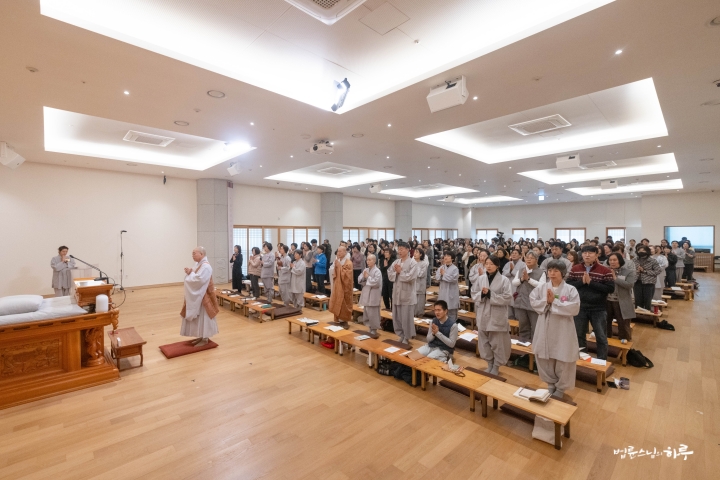
Today’s session began with a Q&A period for questions that had arisen during previous lectures. People from all around the world who were attending online asked various questions. Sunim answered each question thoroughly before continuing with the seventh lecture on the Diamond Sutra. He read sections 11, 12, and 13 of the Diamond Sutra and then provided his explanation.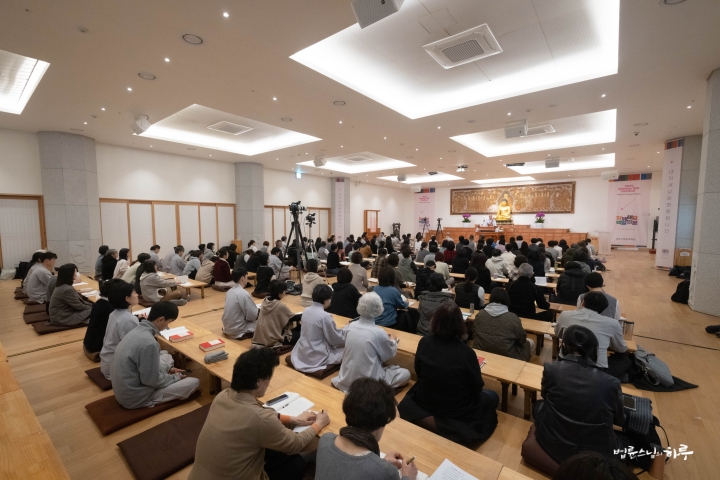
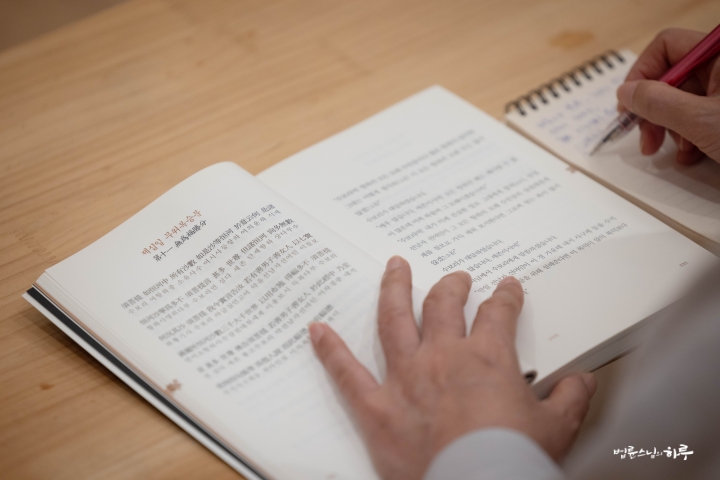
“When we realize the principle that all phenomena are empty, afflictions do not arise. That is, all suffering disappears. However, even if one accumulates numerous merits and becomes Sakra Devanam Indra or Mahabrahma, there is a limit to such merit because, as it is said, ‘When merit is exhausted, one falls’ (福盡墮落). Once the merit is depleted, one falls back into this world. The seeds of suffering are conceived again. This is not sustainable happiness.
‘If a good man or good woman receives and upholds even a four-line verse from this sutra and explains it to others, the merit gained would be superior to the aforementioned merit.’ 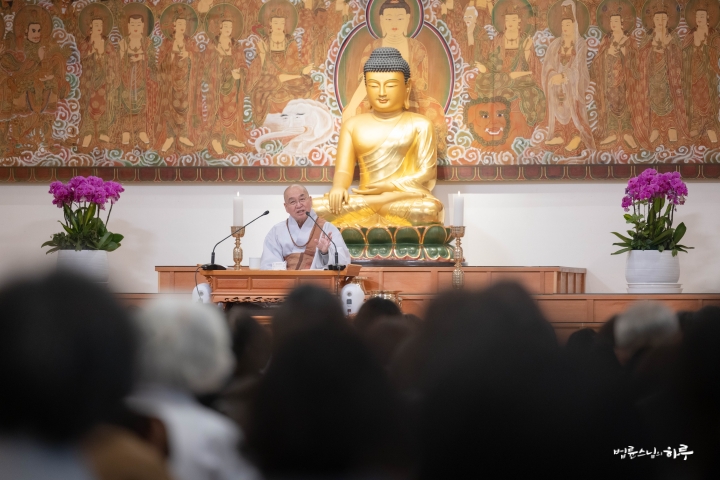
This emphasizes the importance of clearly realizing the principle that all phenomena are empty. While sentient beings constantly desire to receive blessings, this teaching emphasizes that realization is incomparably more important. In other words, receiving blessings is not the central point. In ‘superior merit of non-action’ (無爲福勝), ‘non-action’ (無爲) means ‘without doing.’ Actions performed without any desire or discrimination are called ‘actions of non-action.’ The merit obtained through non-action is superior to any other merit. Rather than focusing on the religious aspects of Buddhism, such as making offerings and bowing before Buddha statues, realizing the principle that all phenomena are empty is far more important. Section 11 of the Diamond Sutra, “The Section on the Superiority of Unconditioned Merit,” emphasizes the importance of awakening and reaching the state free from suffering.
However, if one reads this passage and deviates from the Middle Way, one might mistakenly think that Buddha statues should be removed, that one shouldn’t bow, and that one shouldn’t practice meditation. One might incorrectly believe that merely reciting a four-line verse is sufficient. This, too, is a form of attachment to emptiness(空). Therefore, we must always maintain the Middle Way, neither attaching to form nor attaching to emptiness.” 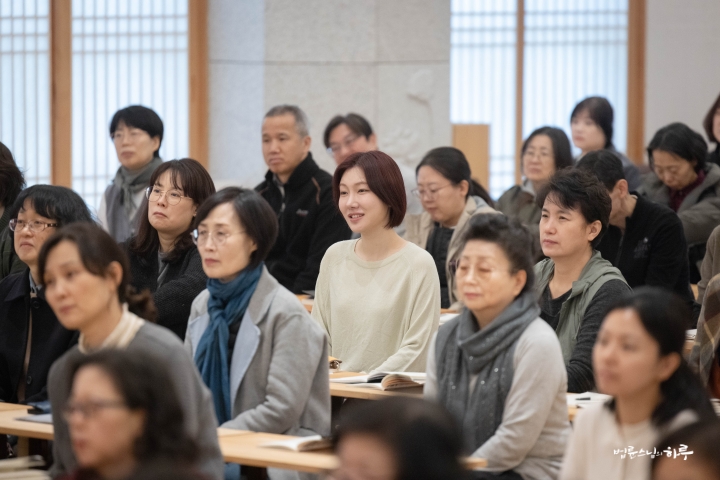
Sunim continued by reading and explaining the 12th section, “Respecting the True Teaching,” (尊重正敎分) and then proceeded to explain the 13th section.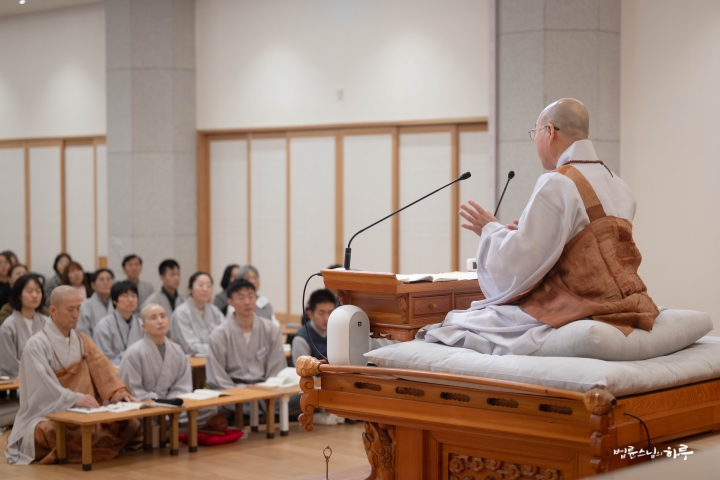
“The 13th section, ‘Receiving and Upholding the Dharma According to the Dharma,’ (如法受持分)means ‘one must receive and uphold the Dharma properly.’ Subhuti asked the Buddha:
‘What should we call this sutra, and how should we uphold it?’
The Buddha replied, “Call it ‘The Diamond Prajna Paramita,'” but concerned that people might attach to the name, he added, ‘What is called Prajna Paramita is not Prajna Paramita; it is merely called Prajna Paramita.’ Then the Buddha asked, ‘Has the Tathagata spoken any Dharma?’ Understanding the meaning, Subhuti answered, ‘The Tathagata has not spoken anything.’ This means ‘the Dharma that the Buddha taught cannot be said to be taught.’ Although we say the Buddha ‘attained’ and ‘taught’ the Dharma that has no fixed nature, there is no Dharma that can be defined as ‘this is the Dharma.’
‘Big and Small’ Are Just Phenomena Arising in Our Perception
The Buddha continued:
‘Subhuti, what are called fine particles are not fine particles; they are merely called fine particles. What the Tathagata calls worlds are not worlds; they are merely called worlds.’ 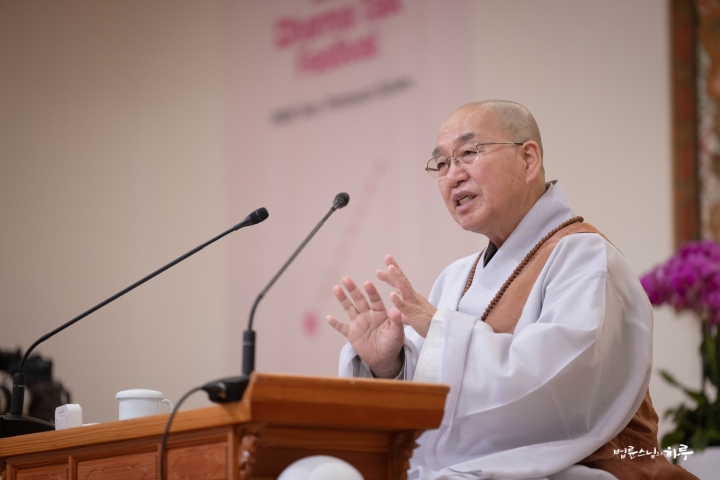
Here, ‘world’ represents the largest thing, while ‘speck of dust’ represents the smallest thing. Compared to speck of dust, a world can be called ‘big,’ and compared to a world, a speck of dust can be called ‘small.’ However, the Buddha is saying that it’s not that speck of dust exist and therefore we call them speck of dust; rather, they are merely called speck of dust. Similarly, it’s not that worlds exist and therefore we call them worlds; they are merely called worlds. This means these are just phenomena arising in our perception, not actual reality. In other words, these distinctions arise in our minds. The Buddha continued:
‘Subhuti, what do you think? Can the Tathagata be seen by his thirty-two marks?’
Let’s examine the statement ‘The Tathagata has thirty-two marks.’ While it’s true that the Buddha had thirty-two physical characteristics, we cannot say ‘the thirty-two marks are the Buddha.’ This is because a wheel-turning sage king also has the thirty-two marks. ‘Buddha’ refers to ‘one who is enlightened.’ It is not determined by physical characteristics. It just happens that Shakyamuni Buddha had these thirty-two physical characteristics. When you become enlightened, people might think, ‘This Buddha has such and such characteristics.’ It’s only because we call someone a Buddha that we think they must have special features. For instance, if someone with a high nose becomes enlightened, then having a high nose becomes a characteristic of the Buddha. If someone with a snub nose becomes enlightened, then having a snub nose becomes a characteristic of the Buddha. Therefore, while we can say the Buddha has certain physical characteristics, we cannot say that someone with these physical characteristics is a Buddha. 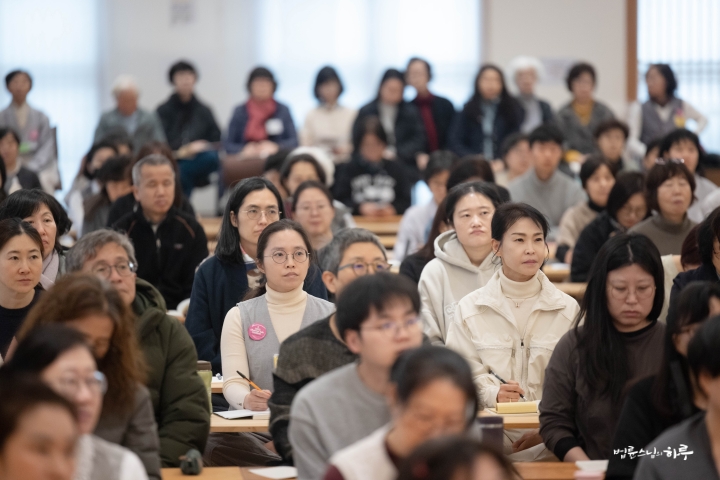
However, when we become familiar with a certain appearance, if someone were to dress exactly like Venerable Pomnyun Sunim, we might think, “Oh, Sunim is here!” This illustrates how we become attached to appearances. The statement “Venerable Pomnyun Sunim looks like this” is a true proposition. Conversely, the statement “This person who looks like this is Venerable Pomnyun Sunim” is not logically valid because “a person who looks like this” and “Venerable Pomnyun Sunim” are not equivalent. For example, “Humans are animals” is true, but “Animals are humans” is not correct because animals and humans are not equivalent categories. So Subhuti answers like this:
“World-Honored One! The Tathagata cannot be seen by means of the thirty-two marks. Why? Because what the Tathagata has called the thirty-two marks are actually not marks, they are merely called the thirty-two marks.”
But when we say this, you might cling to the opposite view of “non-existence.” It is incorrect to say “Someone who looks like this definitely is not the Buddha” or “A person with the thirty-two marks is not a Buddha.” This would mean clinging to the idea of “having no marks.” The key point here is that “one cannot be called a Buddha merely because one possesses the thirty-two marks.” 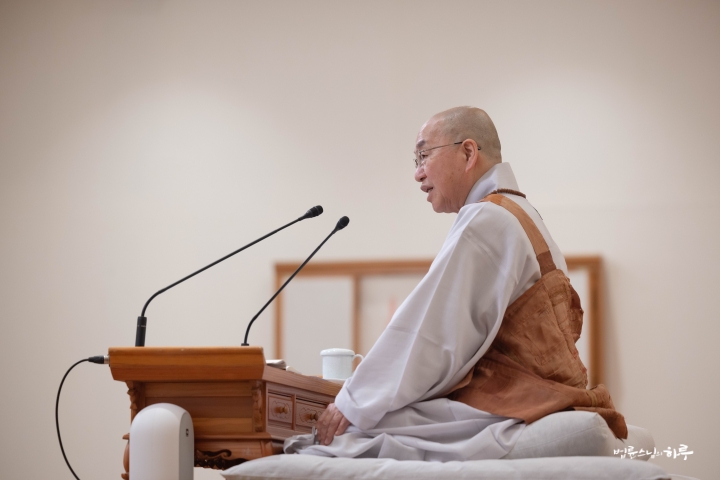
The Buddha continues to use these metaphors to help us clearly understand the principle that all phenomena are empty, meaning they have no inherent permanence. But is it enough to understand only the principle of impermanence? No. We must also understand how existence arises from non-existence according to causes and conditions. When we understand this relationship between existence and non-existence, or form and emptiness, we can live in this world without hindrance. We need to understand both the principle of permanence and the principle of impermanence.
Originally, there were no fixed rules about how people should dress. However, we wear wedding dresses or traditional Korean clothing at weddings, and black clothes at funerals. These customs are loosely established. While there’s no absolute rule that people must wear clothes or must take them off, there are appropriate practices—we wear clothes in public and remove them when bathing. Yet many of you become one-sided, either knowing only the principle of existence and becoming rigid, or knowing only the principle of non-existence and becoming chaotic. When practice goes wrong, one might act recklessly without restraint. This means falling into the sickness of emptiness. Conversely, one might become stubborn about principles, clinging to rules inflexibly.
A typical example is someone who, fixated on the words “reading the Diamond Sutra brings greater merit than any other virtuous deed,” neither gives donations nor volunteers, but only reads the Diamond Sutra. Such a person, when attending a wedding or other event, offers the Diamond Sutra instead of money. This is because they’re obsessed with the idea that offering the Diamond Sutra brings limitless merit. However, the teaching of the Diamond Sutra is to maintain a middle-way perspective on existence and non-existence, or form and emptiness. This is because everything arises according to causes and conditions. 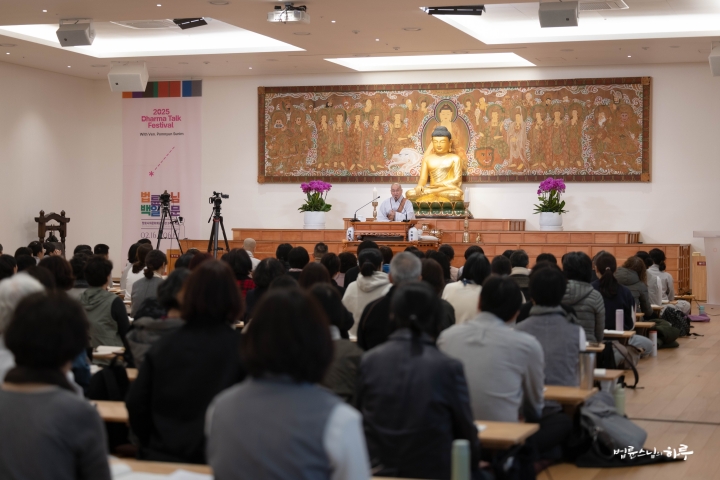
Everything Arises According to Causes and Conditions
There is no fixed route to Seoul. This doesn’t mean there is no way to get to Seoul, nor does it mean you can go any way you like. Once the conditions are set, the path becomes clearly defined. If you start from Incheon, the way to Seoul is eastward! It’s precisely determined. Everything arises according to causes and conditions. What happens if the conditions change? Let’s say you’re heading east from Incheon to Seoul, but you stop in Ansan for the night. The next day, should you continue eastward as you did yesterday? No. From that position, you need to go northeast. This illustrates how everything arises according to causes and conditions. Within the context of time and space, the direction you should take is clearly determined. In other words, this is what we call ‘the Middle Way of that moment.’ It’s also called ‘shi-jung (時中)’ meaning the Middle Way in a particular set of conditions. The Middle Way isn’t predetermined but exists uniquely within each set of conditions.
What does the Middle Way in a particular set of conditions mean? For instance, imagine a woman is crying. She looks so sad and pitiful that you feel compelled to hug her. Then you’re accused of sexual harassment. When desire clouds your judgment, you interpret the Middle Way in that situation according to your own wishes. You need to examine your mind correctly, but if it’s tainted by the three poisons of desire, anger, and ignorance, you can’t find the Middle Way. This shows how the concept of the Middle Way can be dangerous, potentially justifying all kinds of errors. That’s why beginners shouldn’t learn about the Middle Way first. Instead, they need to understand the ‘right path’ through practice. If you become too rigid in your understanding of what is ‘right,’ then you need to develop flexibility. However, you must always examine yourself to avoid becoming careless. Because we cling to form, we speak of emptiness, but if we then cling to emptiness, we fail to understand how things arise according to causes and conditions. That’s why the Heart Sutra says, ‘Form is emptiness, emptiness is form.'” 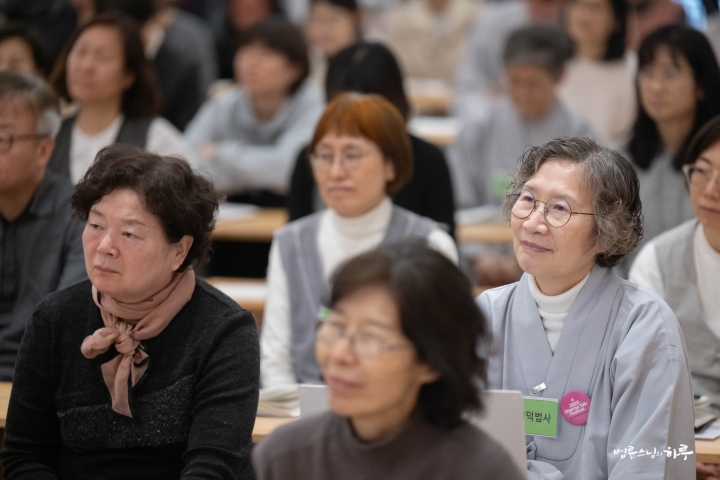
Continuing, Sunim led the group in a recitation of Sections 9 through 13 of the Diamond Sutra, accompanied by the rhythmic sound of the moktak, taking time to reflect on their meaning before concluding the lecture.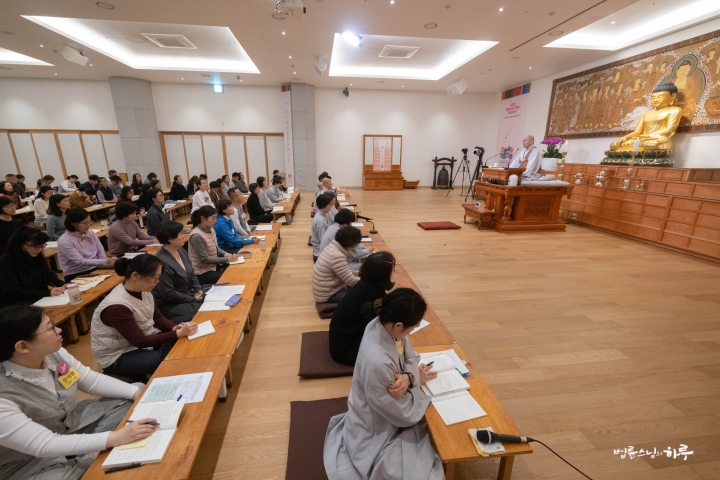

The participants gathered in groups for mindful sharing, while Sunim moved to the dining hall on the first basement floor to have lunch with the Sangha members.
In the afternoon, Sunim worked in the office and prepared for the evening Buddhist Social Studies Course lecture.
As the sun set, at 7:30 PM, Sunim delivered the seventh lecture of the Buddhist Social Studies Course in the main auditorium in the basement of the Jungto Social and Cultural Center. Through the previous six lectures, participants had studied Buddhism’s worldview, practice theory, cosmology, views on life, and perspectives on human existence, along with findings from modern science. Today’s seventh session began exploring society from a Buddhist perspective. The lecture topic was “Life Values Rooted in Buddhist Philosophy.”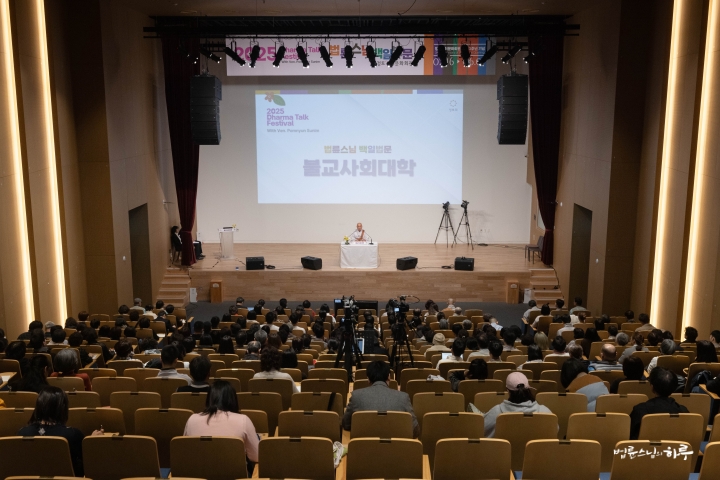
“If a person lives alone, would there be any special rules to follow? One could say both yes and no. If there were any rules, they would simply be not to harm or disadvantage oneself. However, even if one does harm or trouble oneself, it doesn’t become subject to criticism or punishment. That’s why we can say there are no rules. When living alone, whether you walk around naked or do handstands, no action can be judged as right or wrong.
To establish any rules or standards, at least two or more people need to come together. When two people share a room, they need rules and role divisions for wake-up times, bedtimes, cleaning, and so on. Therefore, ethics and morality are not individual issues but social ones. People often think of these as personal matters because they involve individual compliance, but that’s not accurate. They are social issues that individuals are expected to observe. Ethics and morality are social standards that we hope individuals will follow on their own. However, since some people occasionally fail to comply, laws are created to enforce these standards. 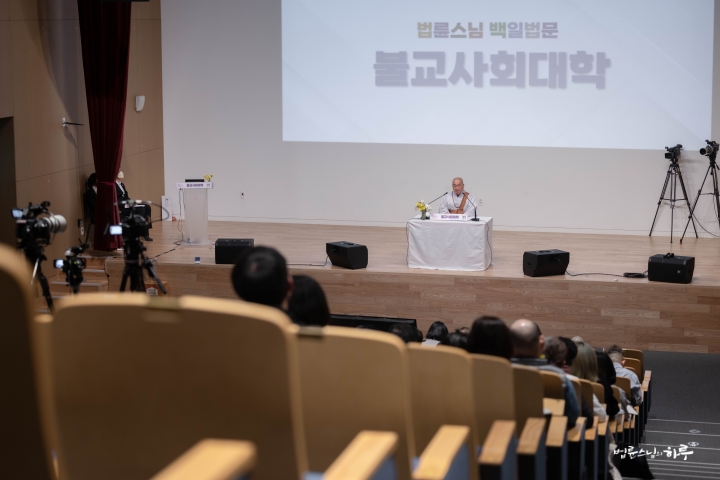
What Universal Values Can Be Agreed Upon Regardless of Religion, Region, or Era?
If ethics, morals, or laws face criticism for being outdated or cause people to suffer, they should be changed. Social systems, cultures, customs, and other social issues can be modified as needed. In other words, they emerge as challenges of the times that require social improvement or reform. However, these values—ethics, morals, and laws—differ according to country, region, ethnicity, and religion. Even within the same society, they change over time. Some actions considered evil during the Joseon Dynasty are now seen as good, and conversely, some previously good actions are now considered evil.
When good and evil vary by region and era, how should we view this? I live in one region with a certain perspective, while someone else lives elsewhere with a different viewpoint. What happens when these two must live together? For example, there is serious conflict between Hinduism and Islam in India. In Hinduism, cows are sacred, so beef is not eaten. In Islam, pigs are considered impure, so pork is not eaten. From an Islamic perspective, Hindus eating pork would seem extremely impure. Conversely, Hindus wonder how Muslims could eat sacred cows. Such clashes in values trigger many social conflicts. This raises the question: “What standard can maintain universality?” What universal values can be agreed upon regardless of religion, region, or era? Buddha said:
“Truth is not verified by ethics, morals, customs, habits, scriptures, or precepts handed down from the past.” 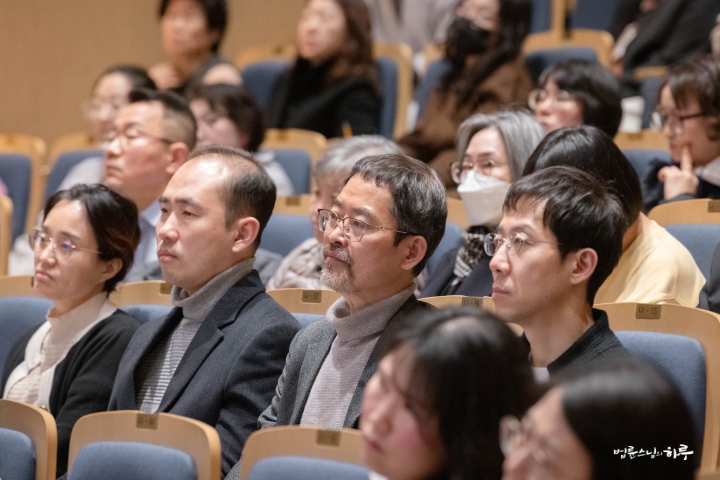
When we typically argue about right and wrong, we rely on ethical standards, morals, customs, precepts, or scriptures. However, Sunim explains that even these cannot be called absolute truth because standards differ across countries, regions, and eras. We cannot definitively state that something is fact or fiction. This is Buddhism’s fundamental perspective—a remarkable insight that transcends all times and places worldwide. If one were Muslim, they might cite the Quran as their standard of truth; Christians might reference the Bible; and Buddhists, the Buddhist scriptures. However, Buddha taught that truth cannot be verified through such means.
Is It Better or Worse Than the Natural Ecosystem?
Buddha used universal validity as his standard, which is based on the natural ecosystem. He viewed the natural ecosystem as an ethical zero base. If something is better than the natural ecosystem, it’s good; if it falls short, it’s bad. Historically, Buddhism may be the only belief system that established human ethics based on ecological ethics, as ancient ethical frameworks were typically human-centered.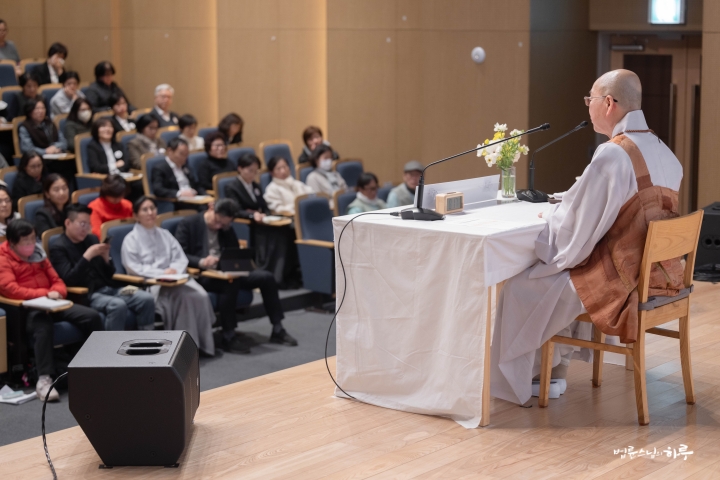
Today, environmental destruction and climate crisis have made it extremely difficult to create a desirable world based solely on human ethics. As a result, perspectives that emphasize ecological ethics are gaining significant attention. This situation may actually help us better understand Buddha’s teachings. Thus, the first aspect of Buddhist values is that they are grounded in ecological ethics.
Is It Acceptable When Considering Both Myself and Others?
Second, Buddhism emphasizes the need to consider both oneself and others simultaneously. This means not speaking solely from one’s own perspective or solely from another’s perspective. For example, before telling someone “Don’t do that,” one should first examine oneself. The teaching is to view both sides, not just one.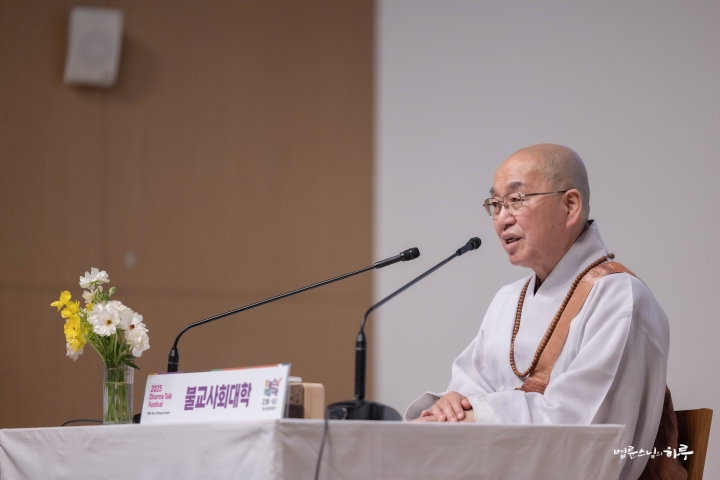
For instance, if you want to say, “Even when married, one can meet other people,” you must adopt the perspective that your spouse can also meet others. If you want to say, “It’s okay to steal things,” you must accept that others can steal your belongings too. If you want to say, “When angry, one can hit others,” you must consider whether it’s acceptable for others to hit you when they’re angry. Buddhism’s value system asks us to examine situations from multiple perspectives—mine, yours, ours—and even consider non-human entities.”
Sunim then explained in detail the five precepts of Buddhism, which are practical moral guidelines. He continued by discussing the significance of these precepts in modern society.
“First, do not kill living beings. Do not carelessly hit or kill living creatures. At the very least, do not hit or kill others.
Second, do not steal. Do not forcibly take or steal what is not given to you. At the very least, do not steal or take others’ possessions.
Third, do not engage in sexual misconduct. Do not forcibly do what others do not want. At the very least, do not sexually harass or assault others.
Fourth, do not lie. Do not carelessly speak what is not true. At the very least, do not deceive others or use abusive language.
Fifth, do not consume alcohol. Do not carelessly consume addictive substances. At the very least, do not get drunk.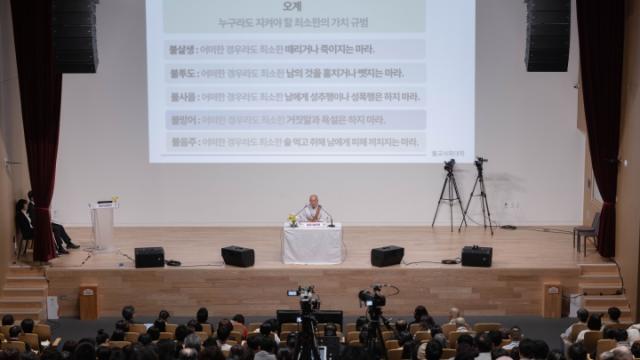
These five precepts are the fundamental values for viewing the world in Buddhism. If these five are well observed, almost all fear between people would disappear. Let’s say you’re stranded on a deserted island with a stranger at night. If you could think, ‘This person will absolutely not harm me,’ ‘This person will absolutely not cause me any loss,’ ‘This person will absolutely not harass me sexually or otherwise,’ ‘This person will absolutely not verbally abuse me or deceive me,’ and ‘This person will absolutely not get drunk and cause trouble,’ then you would have nothing to fear. If these five things are guaranteed, there’s no reason to fear meeting anyone. But even if it’s your spouse, you would be afraid if they use violence, sexually harass you, or get drunk. The same applies to your children or parents. That’s why every person should at least observe these five precepts. If everyone followed just these, perhaps most laws in our society wouldn’t even be necessary. 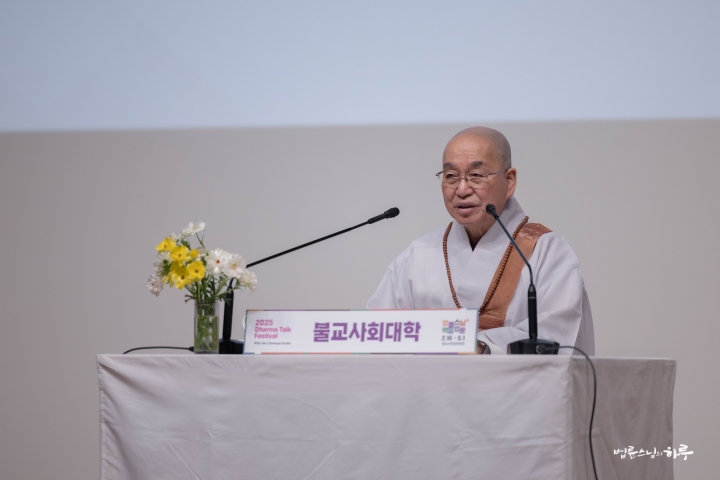
Think about it. If we were to survey the religious affiliations of criminals across the country, would there be no Buddhist practitioners among them? Compared to the general population, would the proportion of Buddhists or Christians among criminals be significantly lower? Therefore, what’s more important than whether someone is Buddhist or Christian is whether they observe at least these five precepts. These five precepts can be considered the basic social values that Buddhists should uphold. When discussed with people worldwide, these five precepts can be universally applied across religions, regions, and societies.
However, we don’t place much importance on observing the Five Precepts. We prefer to believe that faith brings us blessings or engage in ideological debates, rather than considering the values we should actually uphold in the world. The Five Precepts aren’t exclusive to any particular religion. They tell us what attitude we should have when living together and how society can maintain order. That’s why adhering to these values is so important. 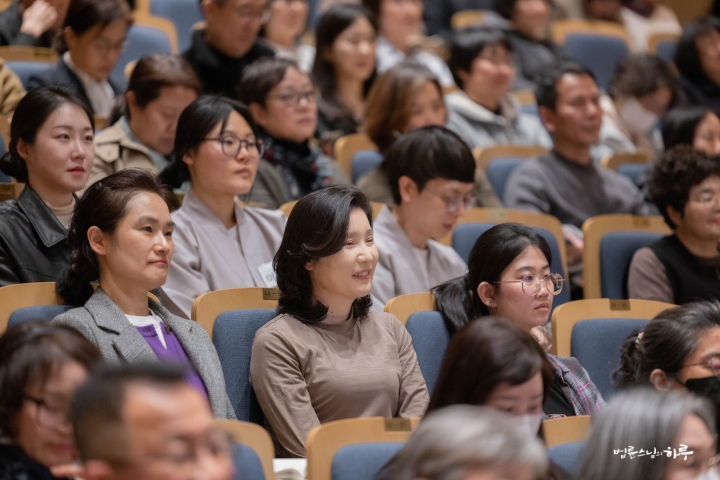
How to Become a Person Respected by Others
In addition to the five percepts, there are three more.
Sixth, do not wear garlands or apply perfumes. Even if you have a lot of money, live frugally rather than extravagantly.
Seventh, do not sit on high platforms. Even if you have a high position, live humbly rather than arrogantly.
Eighth, do not indulge in singing and dancing. Do not fall into pleasures that excite the mind, but maintain equanimity.
No matter how much money I have, I should not waste it or use it carelessly. The precepts state, “Do not be extravagant, do not adorn yourself.” More important than earning or possessing a lot of money is not consuming excessively. Especially in this era of climate crisis, how much we reduce consumption is extremely important. Even if you earn a lot of money and have many assets, if you don’t spend it, it just remains in your name and will eventually be shared with others or remain as public property. More important than equally distributing the wealth of high-income individuals or equalizing income is limiting consumption to a certain level. In the era of climate crisis, if someone consumes significantly more than the average person, they could be considered committing a serious crime that endangers all life on Earth. Therefore, we should not envy those who consume a lot. We shouldn’t consider people bad just because they have a lot of money. However, it’s not easy to live frugally while having a lot of money. That’s why the first of the three additional precepts is “Do not be extravagant,” “Live frugally.” In modern terms, we could say it means “Do not overconsume.” 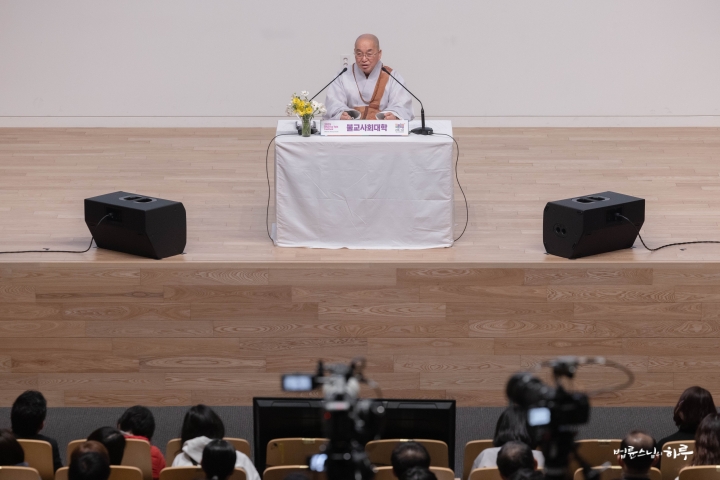
The second precept is “Do not be arrogant; be humble.” Understanding humility as merely bowing to others misses the point. True humility means treating everyone equally. When you treat everyone like an old friend, those above you in status will call you humble, while those below you will say you’re dignified. The hierarchy of status is merely an illusion. When two people meet as equals regardless of status, the person of higher status is called humble, while the person of lower status is called dignified. However, it’s easy to become arrogant when in a high position and servile when in a low position. That’s why the Buddha said, “Practitioners, do not be servile but be dignified; do not be arrogant but be humble.” In essence, live with humility.
The third precept is “Do not indulge in singing and dancing.” This means not pursuing the excitement that comes from singing and dancing. Such excitement contradicts the principle of maintaining equanimity in practice. Excitement cannot be considered happiness in the Buddhist sense. Rather, it is a cause of suffering. Practice means always keeping the mind calm and serene. When something good happens, just respond with a gentle smile. This is the meaning of the precept: “Maintain equanimity” and “Do not pursue excitement.” 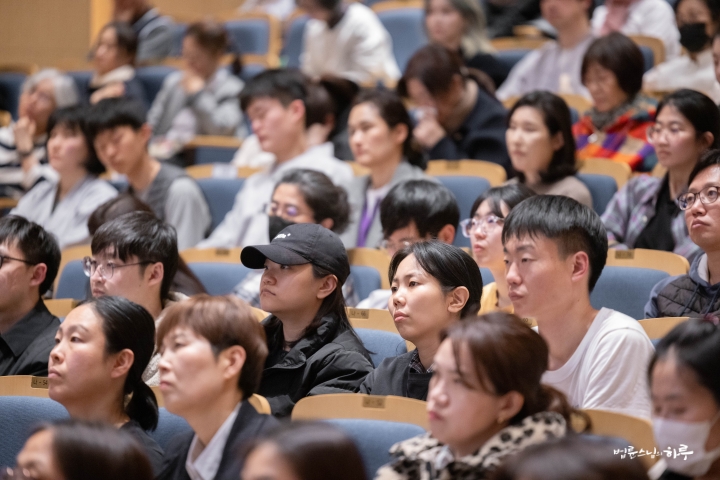
These three together with the five precepts make up the eight precepts (八戒). By observing these eight precepts, one becomes a person of noble character. Even with wealth, living frugally; even with high status, remaining humble; and always maintaining equanimity of mind—such a person is a true practitioner. The first five precepts instruct us not to harm others, cause loss to others, or inflict suffering, while the latter three guide us to purify ourselves. These last three not only prevent harm to others but also earn respect from people in society.
How Should We Live in This World?
It is good to always observe the precepts and to constantly strive to keep them, but moments of ignorance can arise in an instant. In a momentary lapse of emotional control, one might unconsciously throw a punch, raise a hand, commit misconduct, utter profanities, or drink alcohol. It’s easy to show off, indulge in luxury, or pursue fleeting pleasures without realizing it. At such times, one must repent. Repentance involves three steps: First, becoming aware that you have broken a precept. Second, feeling remorse. Third, making a commitment not to break it again. This process of awareness, remorse, and commitment constitutes repentance. 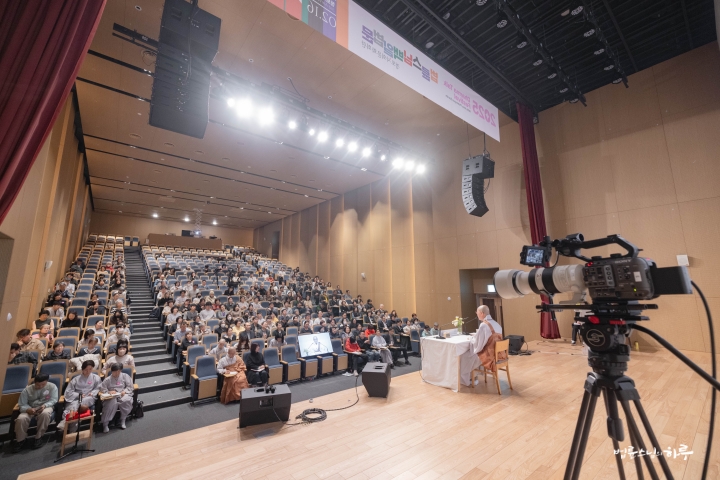
However, no matter how much you repent, become aware, and feel remorse on your own, others might still think, “That practitioner is breaking precepts,” or “That practitioner is always getting angry.” Therefore, you must confess openly before the community. You should reveal your transgressions by saying, “I have broken a precept,” or “I apologize for losing my temper.” This public confession is called “Posal.” When you become aware and repent by yourself, it is called “repentance,” but when you reveal and repent before the community, it is called “Posal.” Often, people don’t realize when they’ve become angry or greedy. So, you should ask your fellow practitioners to speak on your behalf: “Did I break any precepts today?” When you ask this, your Dharma friends will point out your mistakes. This process of becoming aware of and repenting your mistakes through others’ feedback is called “Jaja.” Thus, there are three types of repentance. Through repentance, practitioners must return to their original state.
The same approach applies when addressing social issues. We must examine each issue using the five precepts and eight precepts as our criteria. When a social problem arises, we should ask: “How should we view this from the perspective of dependent origination?”, “How should we view this from the perspective of the Middle Way?”, “How should we view this from the perspective of the five precepts?” Only with these perspectives can we develop wise solutions. Without such criteria, it becomes easy to simply assert, “That’s not acceptable,” leading to greater controversy. When I advocated for humanitarian aid to North Korea during their food crisis, some people objected, saying, “We shouldn’t provide food to North Korea. They’ll use that energy to take up arms and invade us.” In such situations, we must examine the actual conditions in North Korea from a Buddhist perspective. If North Korean citizens are hungry, they need to eat; if they are thirsty, they need to drink; if they are without clothes, they need to be clothed; if they are sick, they need medical treatment. We must approach all problems with these fundamental perspectives.”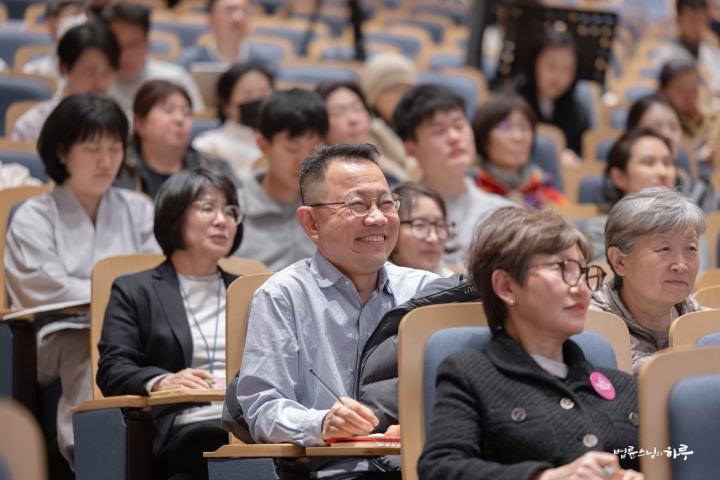
Today’s session focused on learning what values and standards one should live by. The 7th lecture concluded with a plan to explore the topic ‘What is justice from a Buddhist perspective?’ in the next session.
Participants gathered in groups for mindful sharing. During this time, they had the opportunity to reflect once more on what they had learned today.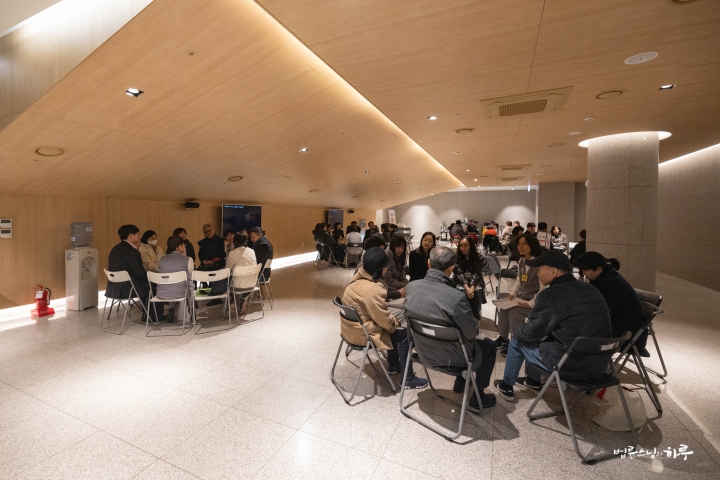
Tomorrow will be the 44th day of the 100-Day Dharma Talk. In the morning, Sunim will teach the 4th lecture of the daytime Jungto Buddhism Course. In the afternoon, Sunim will meet with JTS volunteers to discuss sending an emergency relief team to earthquake-stricken Myanmar. In the evening, Sunim will teach the 4th lecture of the evening Jungto Buddhism Course.




